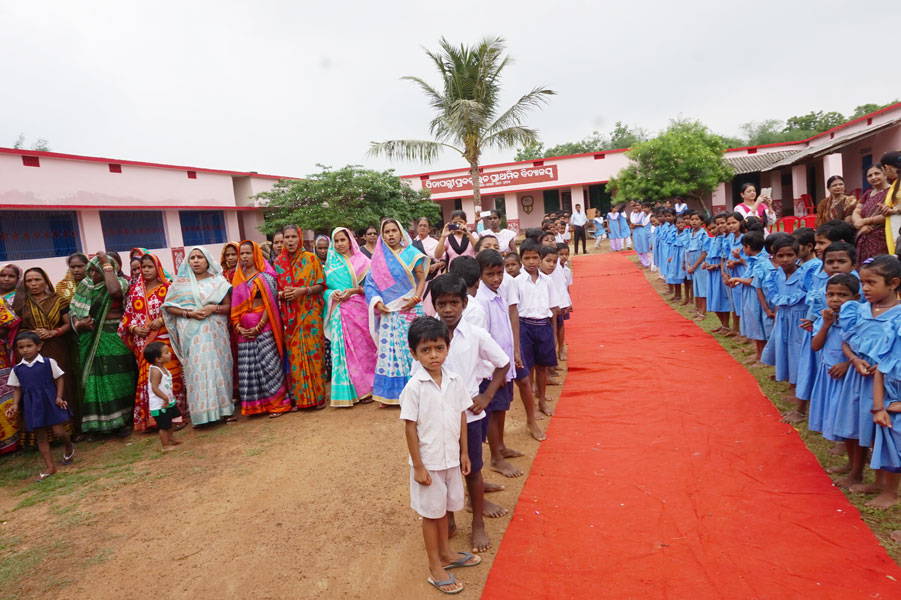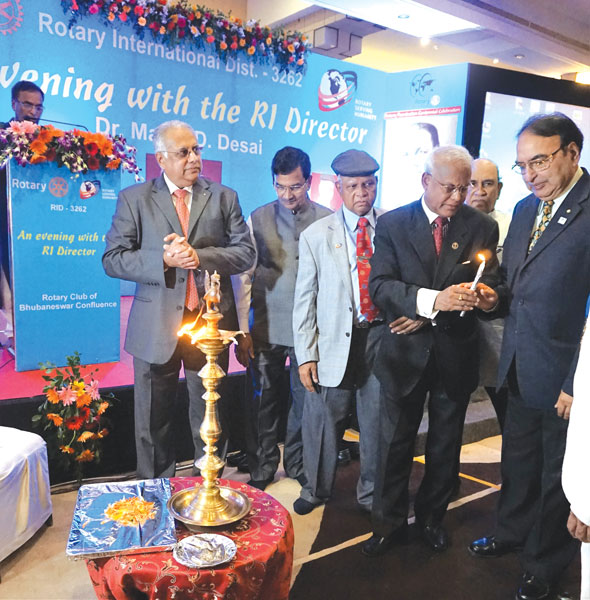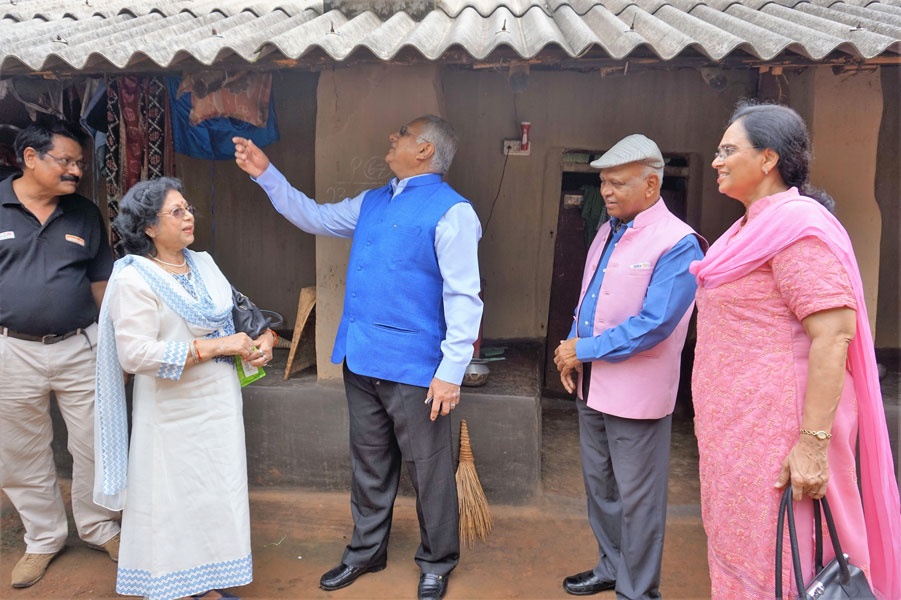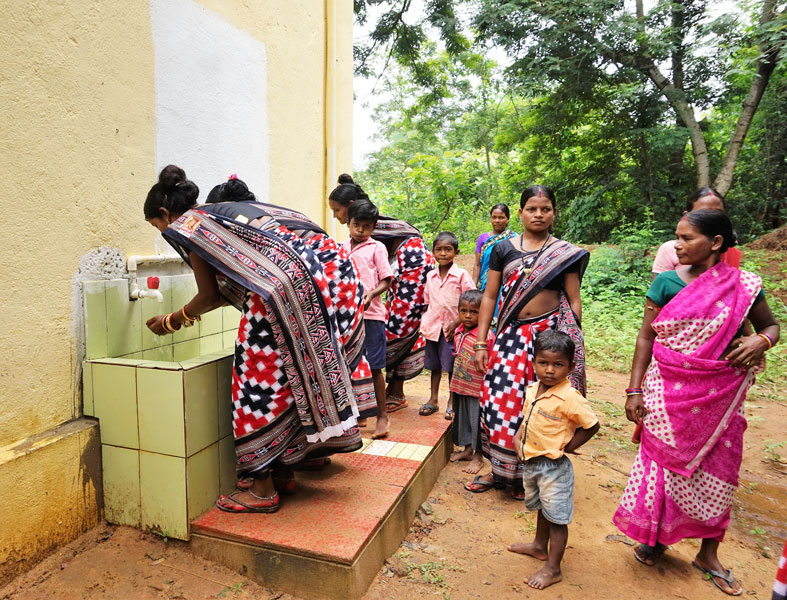As each RI District across the Rotary world gears up to create a record of sorts in doing good to the world through TRF, specially during its Centennial, District 3262 also came out with a novel idea to collect its biggest ever contribution for the Foundation. And it created not one, but two records last month. One was giving an opportunity to every Rotarian of the District to get a Centennial pin by donating just $26.5 — the first donation to the TRF in 1917 by Arch Klumph. “The response was overwhelming”, announced DG Narayan Nayak, at an event held to celebrate this collection drive, a colourful event in Bhubaneswar which was presided over by RI Director Manoj Desai.

Yaha toh jungle mei mangal hei -there is everything in this jungle… electricity, dish TV, mobile phones and even mushroom cultivation!
— RID Manoj Desai
Nayak triumphantly announced that in a single day the District had collected nearly $200,000 for TRF. “Some might say this is not a big amount; but what is important is that we are instilling the habit of giving in the Rotarians of our District.”
Many clubs reported cent percent compliance with each member making the $26.5 donation, and those Presidents were awarded a Centennial trophy by RID Desai.

Nayak said the District had now started getting TRF grants and this year eight projects would be undertaken with TRF help. “Once we complete these, more global grants will come in. Earlier we were a little hesitant about applying for global grants but now find that TRF money is easy to get for need-based projects, for which it is easy to find partners.”
Making a presentation on the future vision of Rotary, Desai, who is on the RI Strategic Planning team, said he had “neither a crystal ball to gaze into, a parrot to pull out cards”, nor was he an astrologer. But he could compare the past with the present and envisage a future which would be drastically different from both.

Recounting his life, Desai said, “My first 20 years went in postcards; today many youngsters haven’t even seen a postcard; from 20–40, the fax was a new phenomenon and we thought: ‘wow, what speed’!” During the two decades from 40–60, when he became a DG, there was neither the mobile nor email. “So we used to send registered mail saying I am coming for a visit; the Presidents would never be ready, and say we never got the letter!”
Future vision
But from 60–80, what will unfold he couldn’t even imagine, he said, showing images of the futuristic Odaiba city of Japan, which would be built over the sea. “Japan has only a thin strip of land, so they have already started taking up space over the sea.”
Giving other examples, such as a futuristic diet which could be taken just by a single pill, Desai said the key words of the last 7 years have been innovation. “When my children were young… in 1973, Kodak was king; do you know the first digital camera was made by Kodak? It had 1.7 lakh employees, sold 85 per cent of the total (camera) film being sold. But a company which was booming when I was young, is gone today.”
The same was the case with the Walkman, which was taken over by the iPod “and where is the iPod today? The iPhone has taken over. And who killed iPod… the same company, the same man — Steve Jobs of Apple. Why? Because before anybody kills you, you have to kill your last product and give the next one.”
Desai added that the keywords for future were artificial intelligence, health gadgets, autonomous and electric cars, new educational methods and schools in the cloud which would revolutionise different sectors in the next five years. “IBM Watson will be able to give legal advice within seconds with 90 per cent accuracy. New health gadgets will come… one in your mobile phone; it can scan your retina, take blood samples and give 54 results in the fraction of a second, and this will happen in three years from now. It will also have a breath analyser; toilet seats will be able to take your blood pressure, pulse and cardiogram, and the results will go to the hospital.”

The message was clear for Rotary: “Don’t keep basking in the past, create new things. Keep doing more.” But despite all these revolutionary developments, the personal touch would remain important. And “Rotary will never lose its relevance, but we will have to keep innovating,” he added.
Desai announced that Nayak will become an AKS member; “he’ll be the first one in Eastern India, and the next man is ready, the discussion going on. That’s the way to move forward, but somebody has to start.”
A model village
The morning after the TRF event, it was time to visit two Rotary projects — done by RC Bhubaneswar Confluence and RC Bhubaneswar Kalinga. The first project was the tribal village of Pitagadia, about 45 km from Bhubaneswar, which has been adopted by RC Bhubaneswar Confluence for several years and where the club has been working meticulously to change the lives of the villagers. As we drive there, through lush green forest land and a sturdy road which is not made of clay but cohesive non-swelling soil, and doesn’t come apart during the rains.
Lalit Behera, a member of the club, briefs me on how the Rotarians have started a school here and every year “we send 5 to 6 students from here to KISS (Kalinga Institute of Social Sciences, which was featured as a Rotary News cover story in October, 2015)
This club has adopted Pitagadia for the last several years, and built a school here. Actually, now that the central government sanctions Rs 12,000 for building a household toilet, “we have constructed toilets for all the 30 households. We give the work to contractors and do the supervision and we give them good toilets.”
But the club members also realised that if running water was not provided the tribals might use the toilets for storing their firewood during the monsoon, “and the entire project will get destroyed, because in the rainy season the priority of tribals is to protect their firewood,” says Sishir Kumar Patnaik, president of the club.
So they put a boundary around the school, built a 10,000 litre tank which is kept here and connected it to all the 30 houses. The water source is a tube well 700 ft deep.
Next the Rotarians got the village women cultivating mushrooms on beds of straw. “We told them that your work is to grow and we will find a market for them. Now they are getting a good income from mushroom cultivation,” says Behera.
Total transformation
How the lives of poor and backward people can change if they find a godfather can be seen from this, a quintessential Rotary project. The club members have turned the adjoining green area into a football field and regular tournaments are held here and prizes given. “Youngsters now come here from other tribal villages and we conduct football tournaments. Earlier the prize was a goat, “but we have now got them a big cup, which the winning team gets to keep,” he adds.
Next the villagers will be given goats and urged to start goat rearing… “as this is a green belt there is no problem of grass for the goats. And people from Bhubaneswar will come searching here for mutton as there is a dearth of good mutton there,” smiles Rtn Haragopal Patra, who is keenly involved in this project.
Also, earlier the tribals were taking bamboo from the adjoining forest and just selling it at Rs 20 to 30 in Bhubaneswar for what would normally cost Rs 200. The Rotarians have trained them to make some products out of bamboo, guaranteeing that they will market it for the villagers; “so earlier while they were cutting 10 bamboos from the forest and selling it so cheap, now they cut only one bamboo and get the same income from it. At least jungle toh bachh jayega,” he adds.
I am accompanying RI Director Manoj Desai and spouse Sharmishtha to the two villages where Desai inaugurates some toilets. As Pitagadia is also famous for its group of tribal women dancers, the women are dressed up in beautiful black and red traditional Vichitrapuri sarees of Odisha, gifted to them by the club, for this special event. The delegation is greeted with drums, music and dance, and soon Desai and Sharmishtha are whisked away to dance with the tribal women.
Addressing the meeting, Desai says it is amazing to find how RC Bhubaneswar Confluence has totally transformed the lives of the villagers… “yaha toh jungle mei mangal hei (there is everything in this jungle)… electricity, dish TV, mobile phones and even mushroom cultivation!”
A WinS project
We next visit Pitapalli, about 35 km from Bhubaneswar, where RC Bhubaneswar Kalinga has built toilets for homes as well as a WinS project for the local school. Club President Col S N Roy leads RID Desai and DG Nayak to the reception area where another grand welcome by drummers and tribal dancers, as well as neatly dressed schoolchildren, is awaiting them. Here Desai inaugurates a spanking new toilet block and hand washing station, and regales the Rotarians with stories of how at the RI headquarters in Evanston he is known as the ‘Toilet Director’!
Nayak announced that this year D 3262 will build 2,000 individual household latrines, for which project the chairman is Rtn Anup Panigrahi and implement the WinS project in 200 schools.






